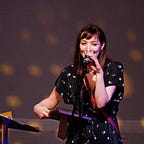Turner Contemporary x Storythings — Week 6
Catalyst Development programme weeknotes, 1st — 5th March
Hope and connection
Following on from “end personas” and the team thinking around how we can use art to start a conversation around hope and connection, Storythings refined these ideas into two proposed format ideas based on the two concepts. On Monday, Storythings led a second Format Development Workshop with me and my colleagues, this time digging into these proposed ideas and questioning what works. We enjoyed the idea of sharing personal connections and stories, and talked about how we could make sure that the structure, if phrased as “game-like”, didn’t trivialise artworks with sensitive subject matter. We wanted to ensure that the model developed would be easily reusable beyond this moment of increased remote contact, and talked about how these experiences can be made shared ones.
The workshop left us with many questions to think about, e.g. how do we make these journeys shareable and social by the end? Storythings delved a bit deeper into these formats and drafted a detailed outline for both formats with next steps, whilst we thought about which artworks could work best for each format. Both of these formats are episodic and require you to respond to an art inspired prompt in some way. Over the course of the series you build up a story informed by personal connection.
- The “Connections” format: This format encourages the participant to find extraordinary connections between themselves and an artwork. Over several episodes, they are sent down rabbit holes of local and art history to see who can find the most incredible, but real, connections. This format requires them to research and find interesting facts. Starting from a chosen work of art, players are given a set of special challenge cards to find locations, artists, objects or events that form a chain between the artwork and themselves. By the end they’ll have a unique and rich interpretation of the artwork inspired by facts and personal connection, which they can share at the end.
- The “Hope” format: Every participant receives a special letter in the post, asking them to think about someone they’d like to meet who they have missed. The letter will explain that Turner Contemporary will send them a series of questions and artworks over email to help them write a story that they can send to this person, helping to reconnect them. These will be open-ended questions, allowing participants to answer in a manner they are most comfortable. In response to each question, participants will be asked to respond with text or with an image. Thus, once participants have answered the set of questions, we will have a unique response collage of each participant’s response to the selected artwork. To build community, the project host will curate and share some of the responses with each email, giving a sense of a community to each cohort taking part in the project, and helping to inspire their responses. The hope is also to reproduce a physical copy of the responses to give to the participant.
